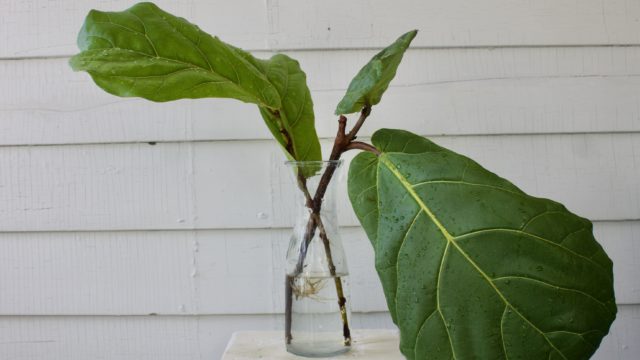
One day Filbert the Fiddle Leaf Fig became too tall.
His head hit he ceiling, his trunk was leaning – no longer was he petite and small.
One day he was chopped, he and I stood in shock, as the top half of him began to fall.
But then I realized there’s no reason to cry – soon well have a few more Filberts after all.
Filbert, as explained in my Dr. Suessian intro, was hitting my 10′ ceiling and, quite honestly, I couldn’t let him get any taller. He was one spindley trunk that leaned heavy to the right with leaves spaced very far apart. Fiddles are finicky, and he was my learning curve in figuring out the best lighting and conditions for them to flourish. I’ll admit, his appearance suffered a bit.
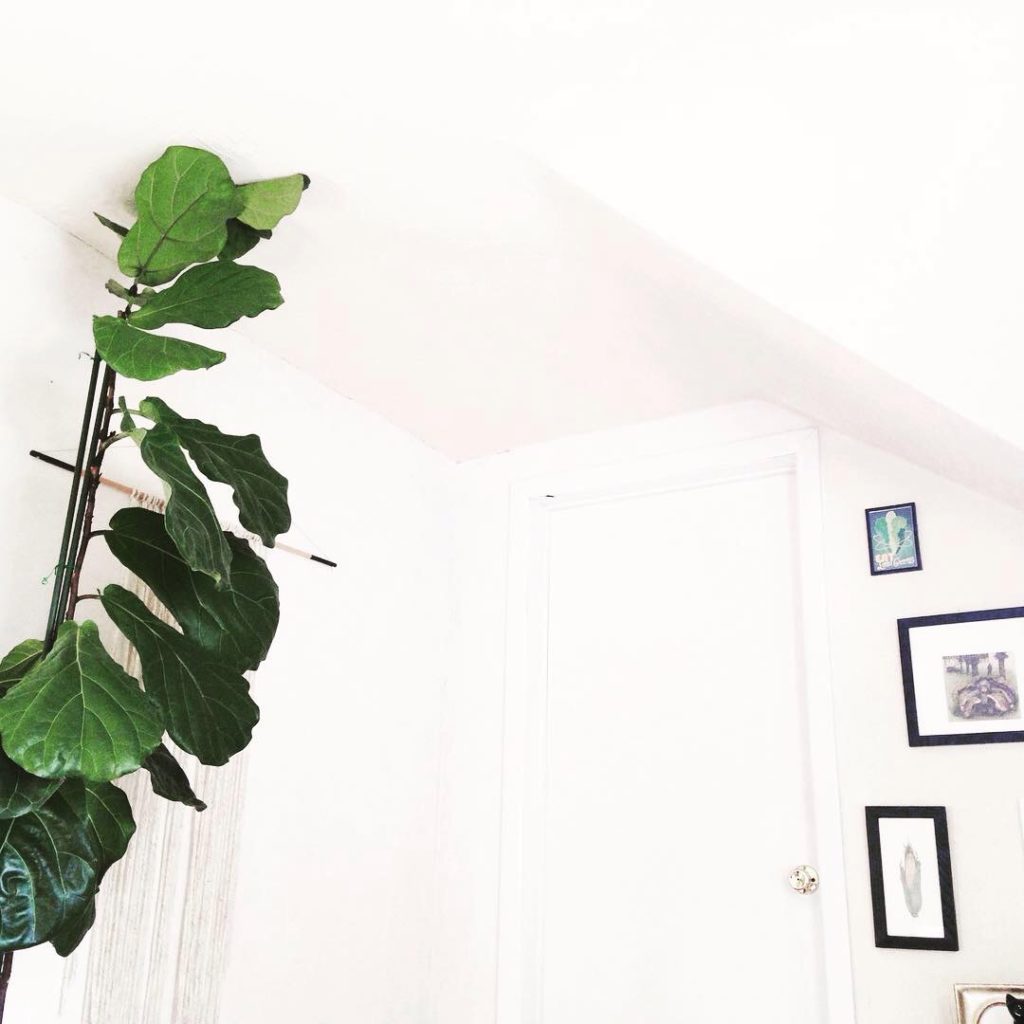
My post about propagating my Monstera is my most popular on this blog, and quite honestly, on Google. I explain how terrifying propagating is and how my only reason for actually doing it in the first place was to trim Monty down to a manageable size. Well, here we go again.
Why you should propagate.
Before I dive into the terrifying experience that is cutting a 10′ tree in half, let me explain why you should prune your Ficus Lyrata. One, it makes them look fuller (like any plant) and two for health reasons – it promotes more stems and growth. Many of the Fiddles you see in Crate and Barrel and Architectural Digest are a multi-stem tree full of yummy leaves like this:
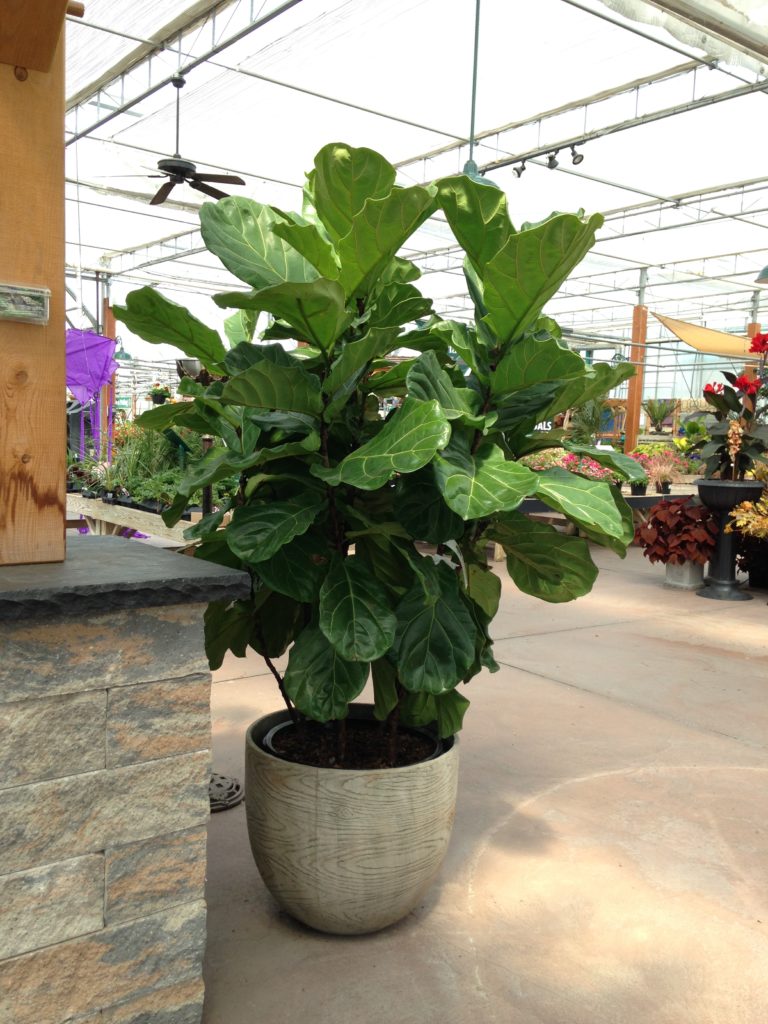
Almost all “how to propagate a Fiddle Leaf Fig” posts I found was using a multi-stem and multi-branch plant (ugh, see above). So if you have this situation, that’s great. I also saw there is always a chance the plant can either die in the process or not root, but it’s usually fine since there are multiple stems to work with. I don’t know if you noticed, but Filbert was one trunk and, like, a branch. I didn’t find another person who chopped down their single stem Fiddle Leaf Fig and had it work out. SUPER.
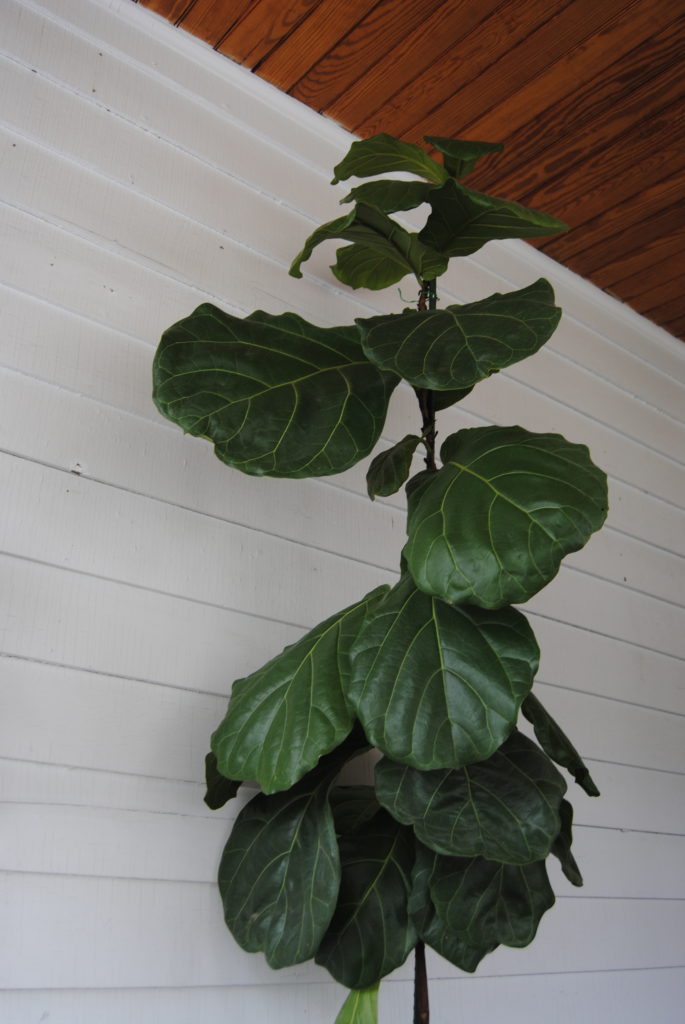
So here I was again, terrified to chop up another one of my beloved and named plant friends. Even though my confidence was slim in the beginning, I now have two happy and healthy mini Filberts. Here’s what to do.
Propagating a Fiddle Leaf Fig.
I chose to propagate a Fiddle Leaf Fig in water. This is the most painless way to propagate and most fun to watch. At this point I have successfully propagated two Ficus lyrata in water and they both gave me chubby, healthy roots.
You’ll need the following tools:
-A clean space
-A pair of sharp, sterilized, heavy duty pruners like these.
–Bottle or jar to hold the cutting
-Non-chlorinated water to fill said jar
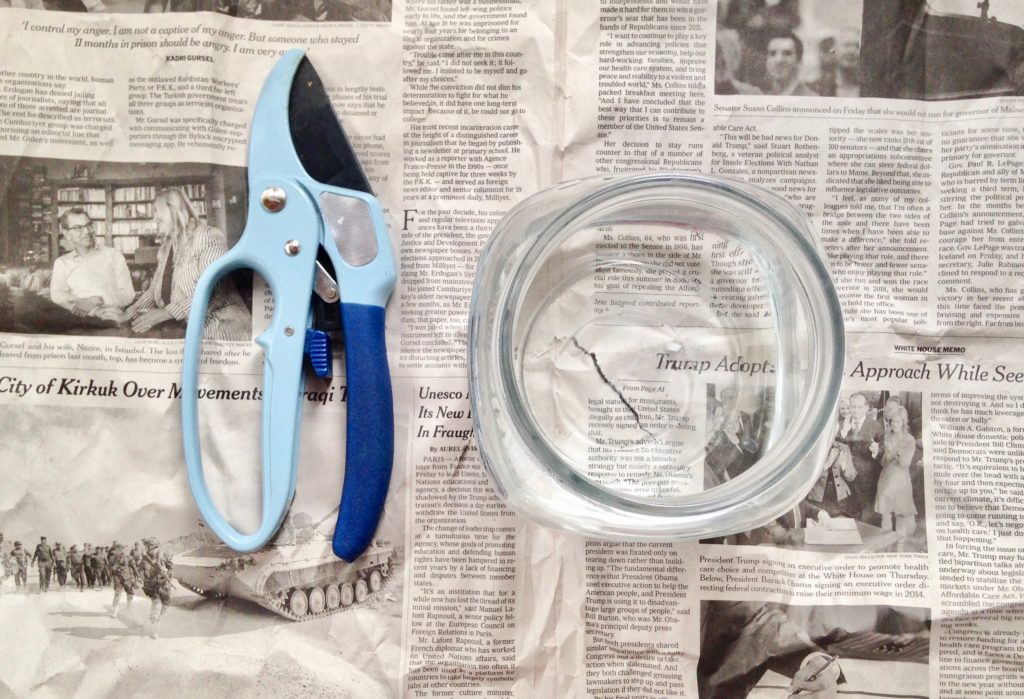
Where should I cut?
First, think about where you’d want new growth. You need to keep leaves on the Mama plant, so don’t got crazy. I chose a spot where it would look “nice” to have new branches and would look fuller.
This is very important: be sure to choose an area where there are leaves underneath. Again you don’t want a bare plant, so you want a spot with plenty of healthy growth below it. You’ll probably have to trim some leaves from the cutting, too.
Alright let’s do this.
- Identify where you want to cut and make a clean cut.
Be sure to use heavy pruners so you don’t struggle like I did.
- Remove any lower leaves.
The cutting should have 3-4 leaves max so its energy can be spent creating roots.
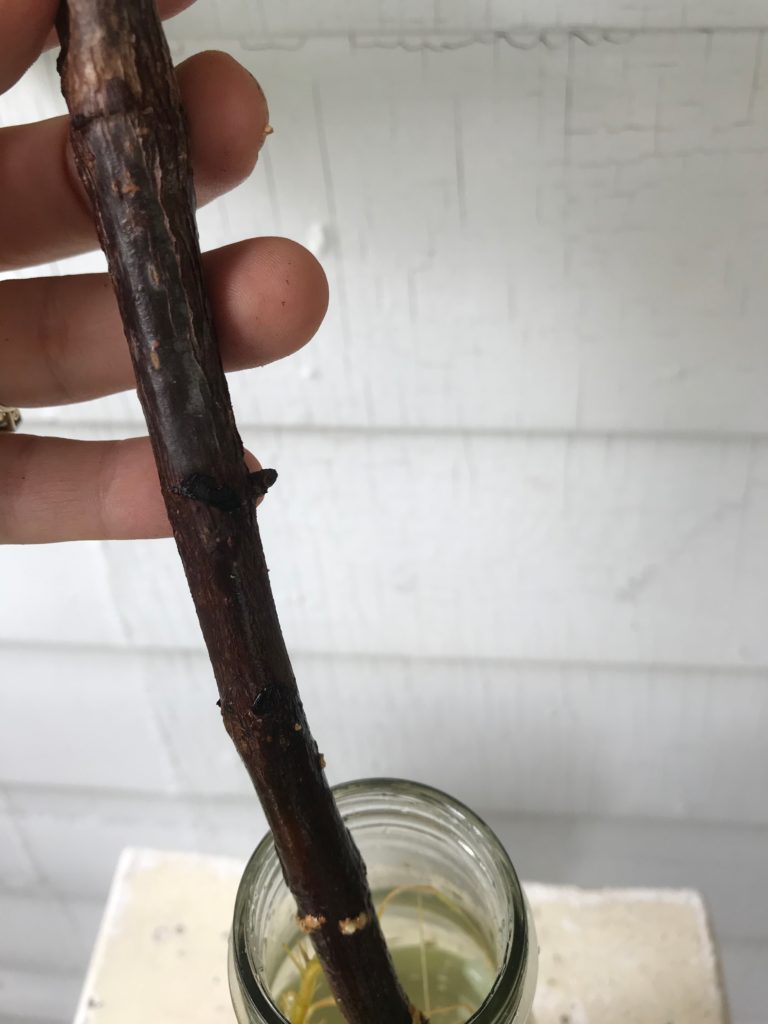
- Place the cutting in the jar with water.
Be sure there is enough space so when roots do grow, it isn’t a tight fit. Fill about 1/2 way with water.
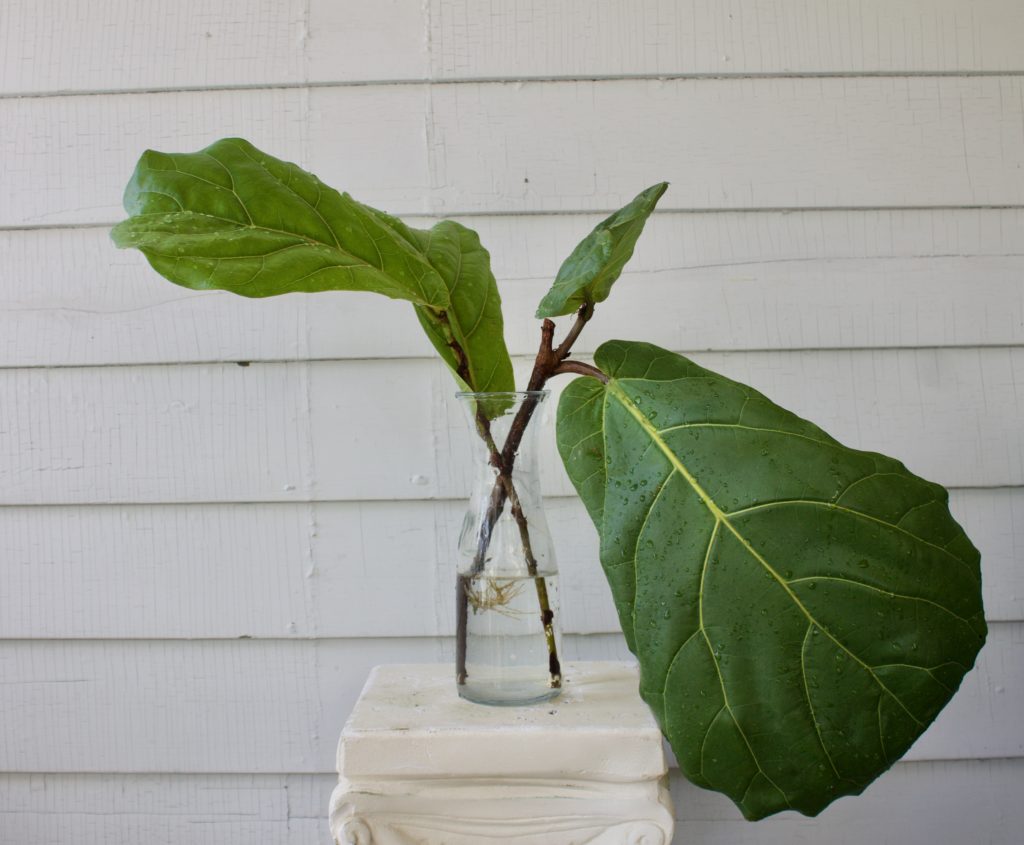
- Place in a sunny, bright location that’s warm.
No drafts or depressing corners, please.
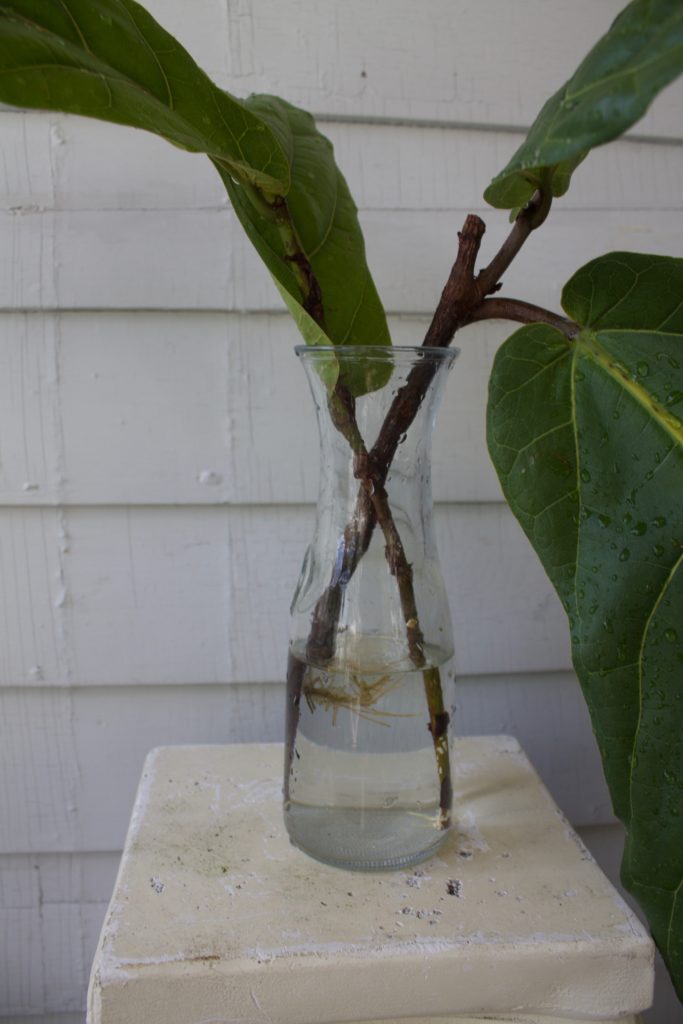
Waiting for Roots
After this initial chop, nothing happens for a while. And depending on the season (like if it’s winter) that may be a long while. Just be patient.
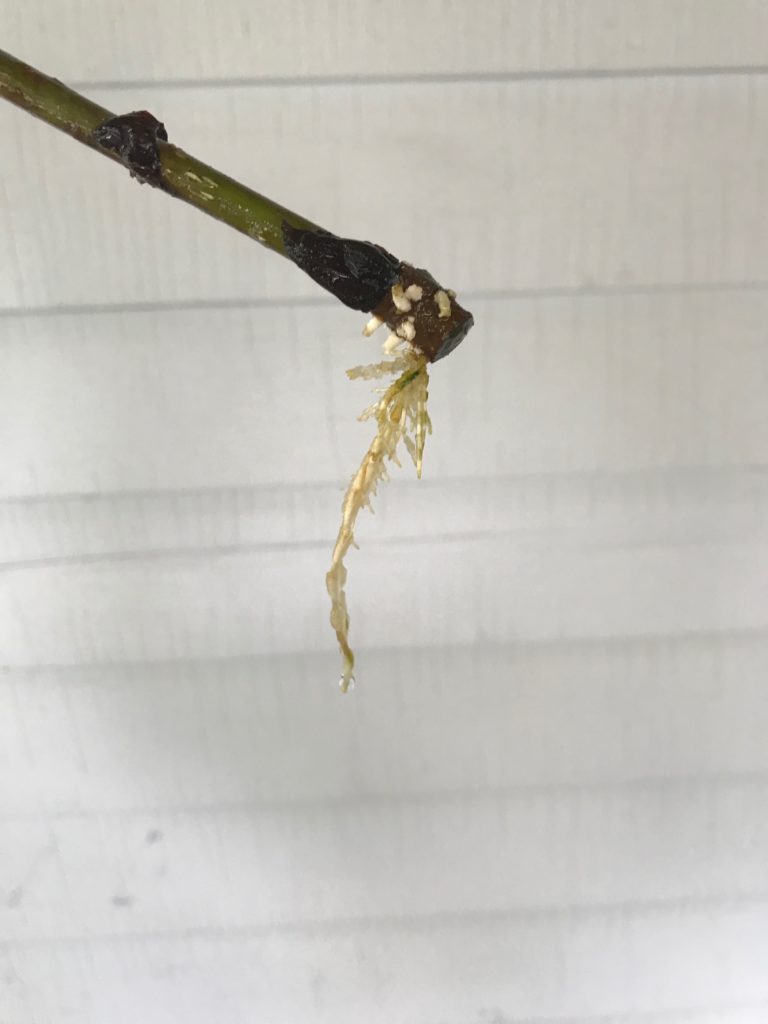
What comes next might be weird, but it’s totally normal. You’ll see fuzzy, barnacle-looking white spots pop up – and that’s good! These are roots forming. Do not pick them off or find them gross. In due time these become fuzzy white roots and eventually plump up.
Some other things might happen too – you may see a new leaf pop out and that great! A new bud may appear on the side and that’s great too.
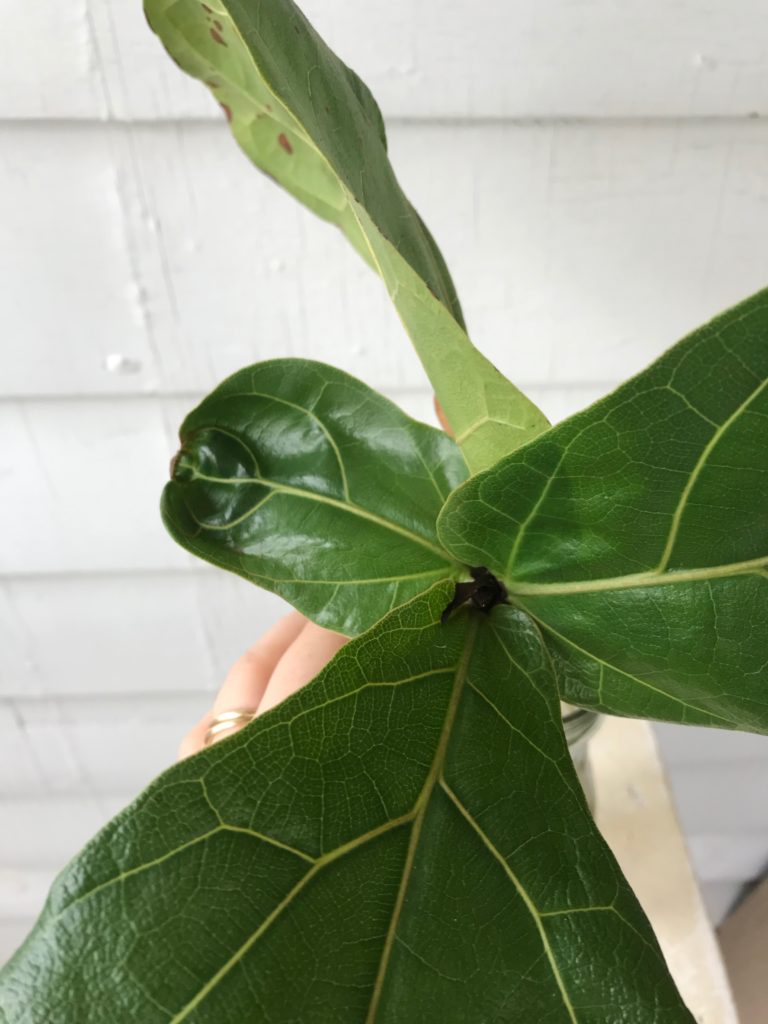
The Mama plant will recover just fine and you should see some new growth very soon near where the cutting was taken.
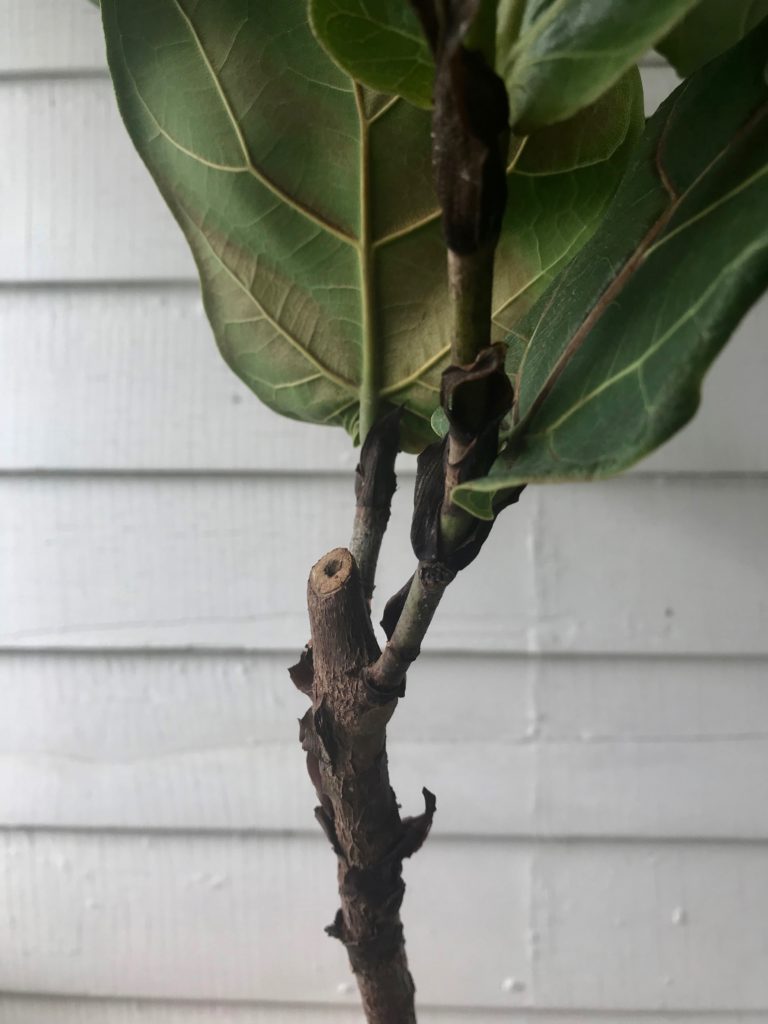
When to Repot
Once the roots look beefy like this (see below), it’s time to plant!
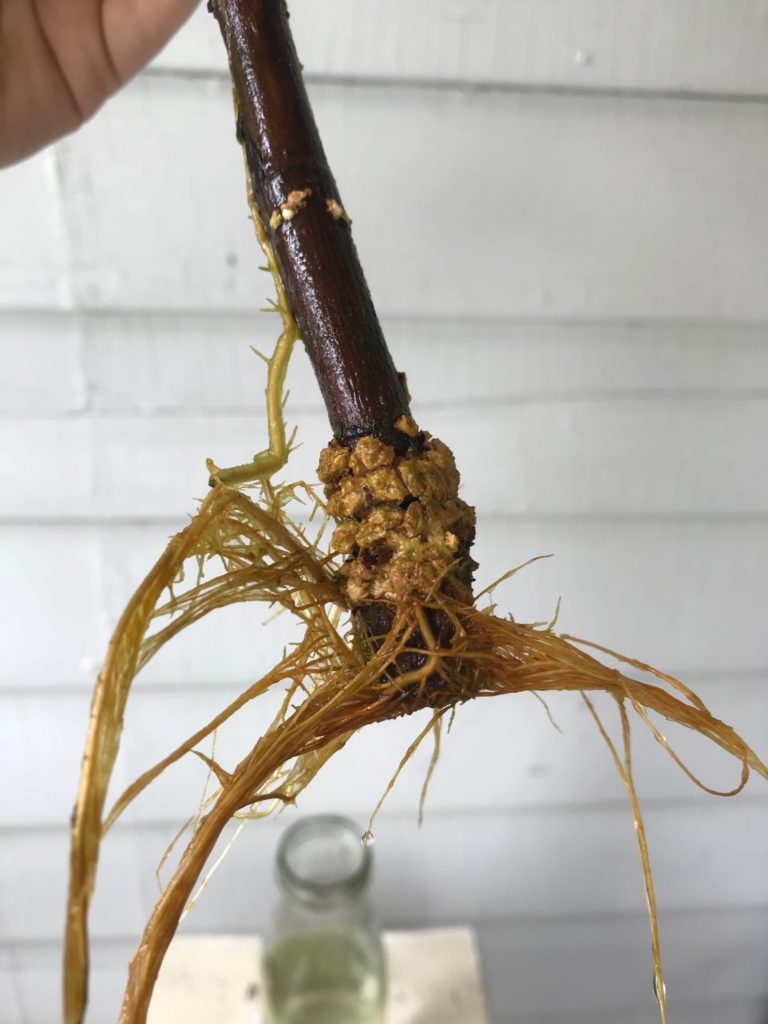
Potting is pretty simple, it’s just like potting up a regular plant.
You’ll need the following tools:
-A clean space
–High quality potting soil mixed with perlite
-A planter

Step 1: Pour some soil in the bottom of the planter so the cutting has an anchor and doesn’t tip over.
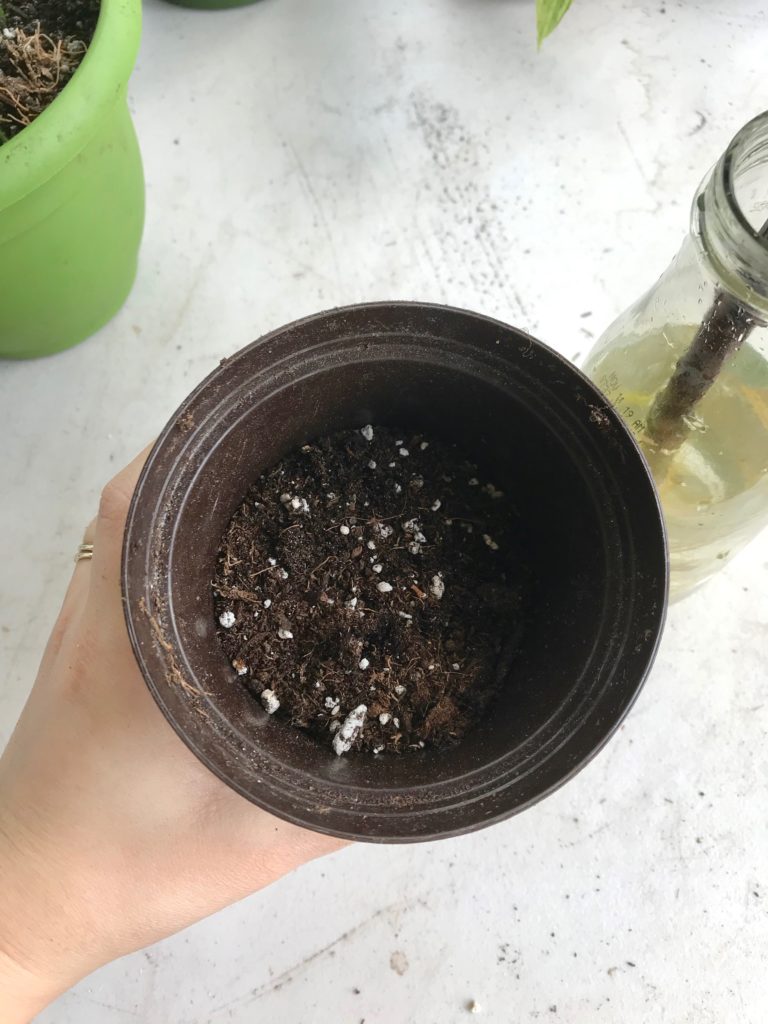
Step 2: Insert the cutting and cover it with soil gently.
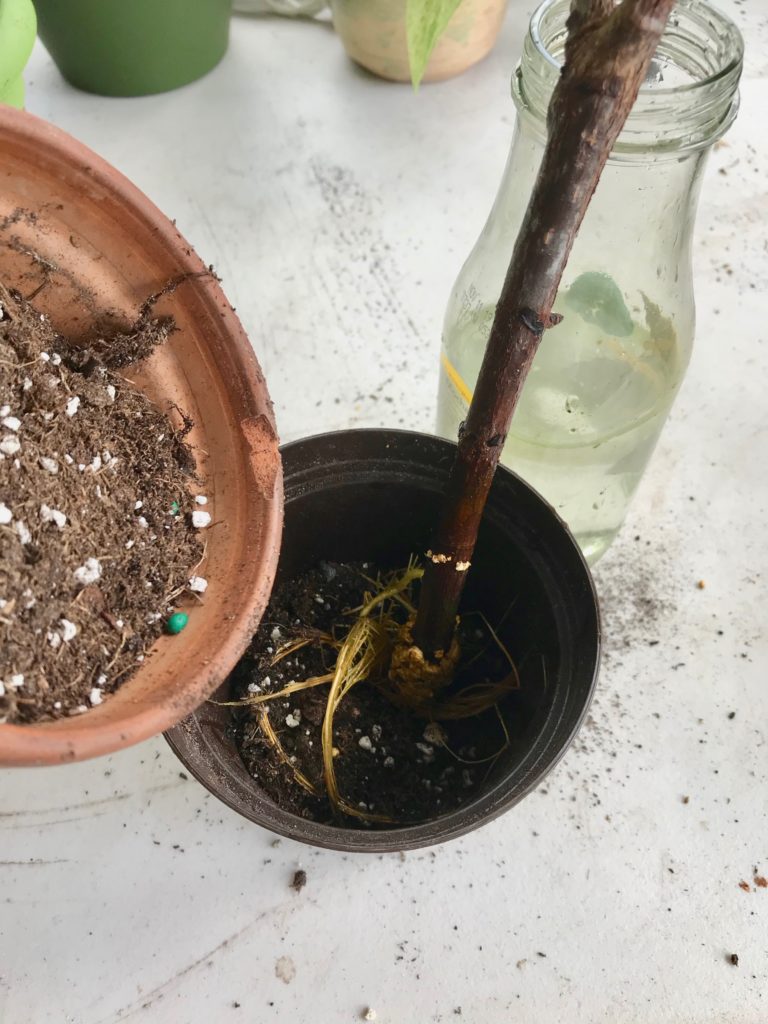
Step 3: Be sure not to pack it down.
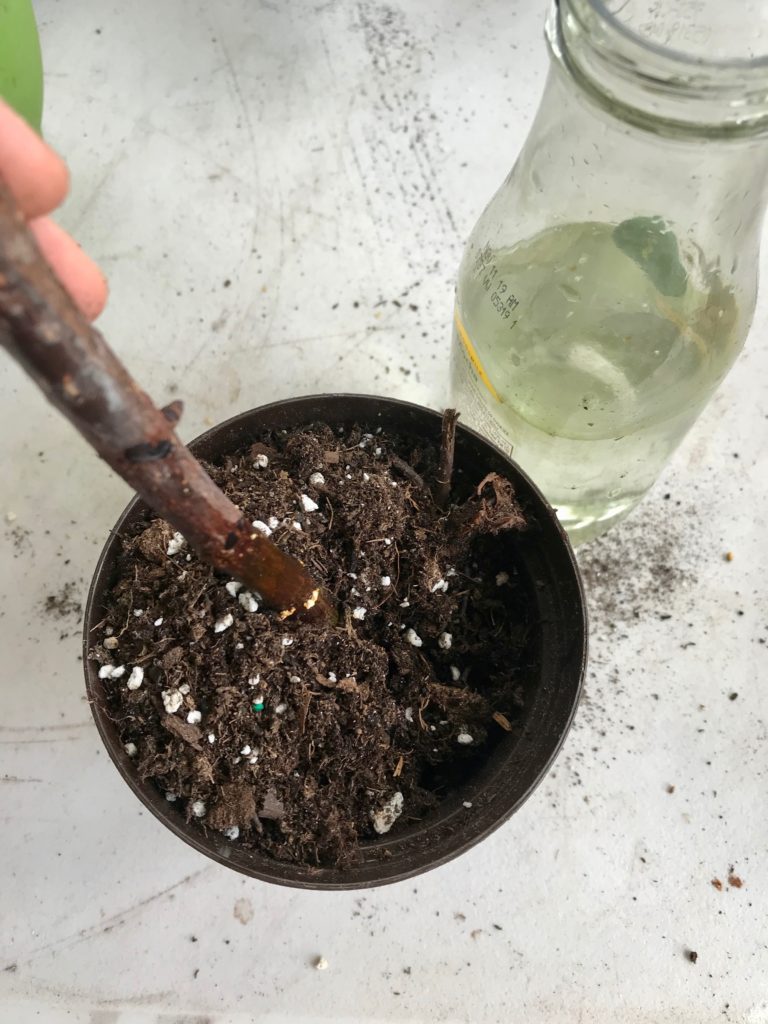
Step 4: Water thoroughly until water comes out of the bottom and the soil is damp with no dry pockets.
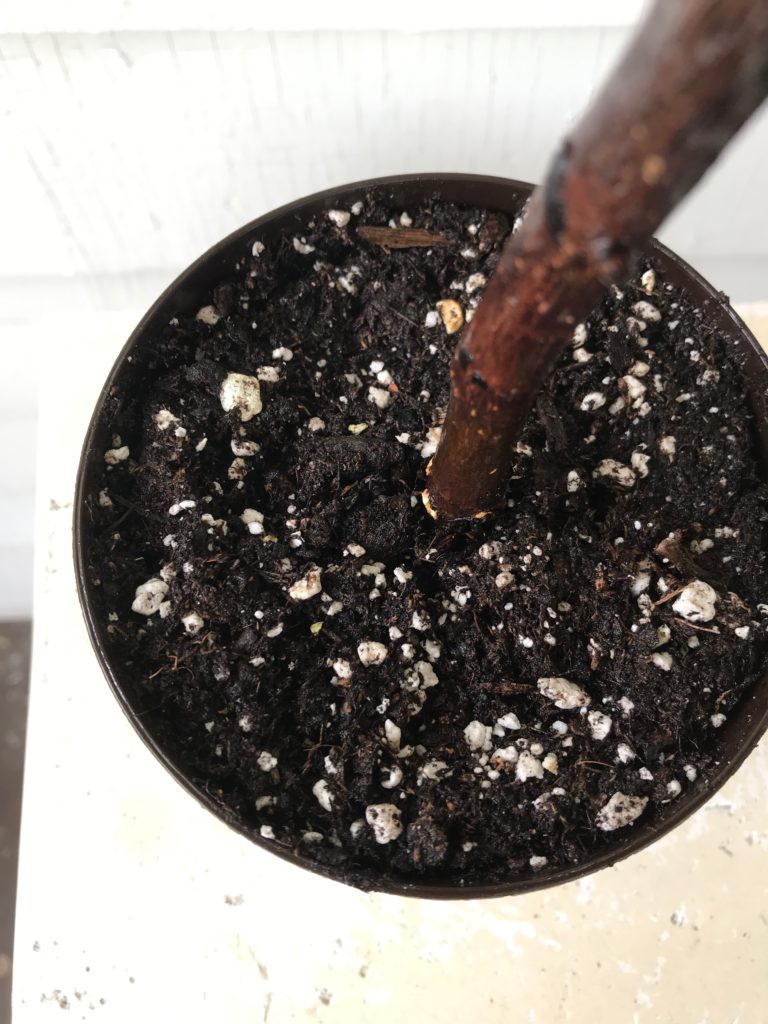
Step 5: Ta da! Straighten the cutting so it’s not crooked and place in a warm, bright location.
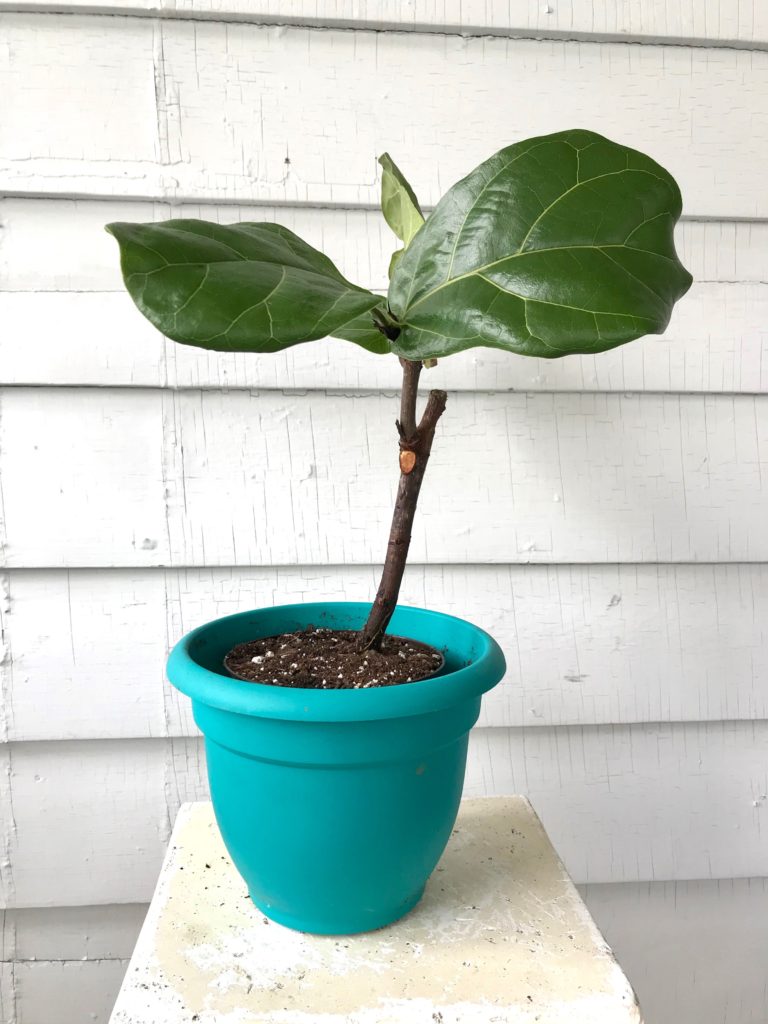
Propagation Problems
Here are some things you don’t want to see:
-The stem turn black and mushy
-Its leaves all turn yellow and fall off
-Mold appears on the stem
These are all bad signs and a signal something went wrong. Your plant may have had an issue before you propagated, or your water may be too chlorinated. Either way, the cutting cannot usually be saved.
Propagating Fiddle Leaf Fig Leaves
Sometimes a leaf pops off and you think, sure let’s propagate it! That’s fair. But I have bad news, you can’t propagate a Fiddle Leaf Fig with just a leaf. This is called a blind leaf.
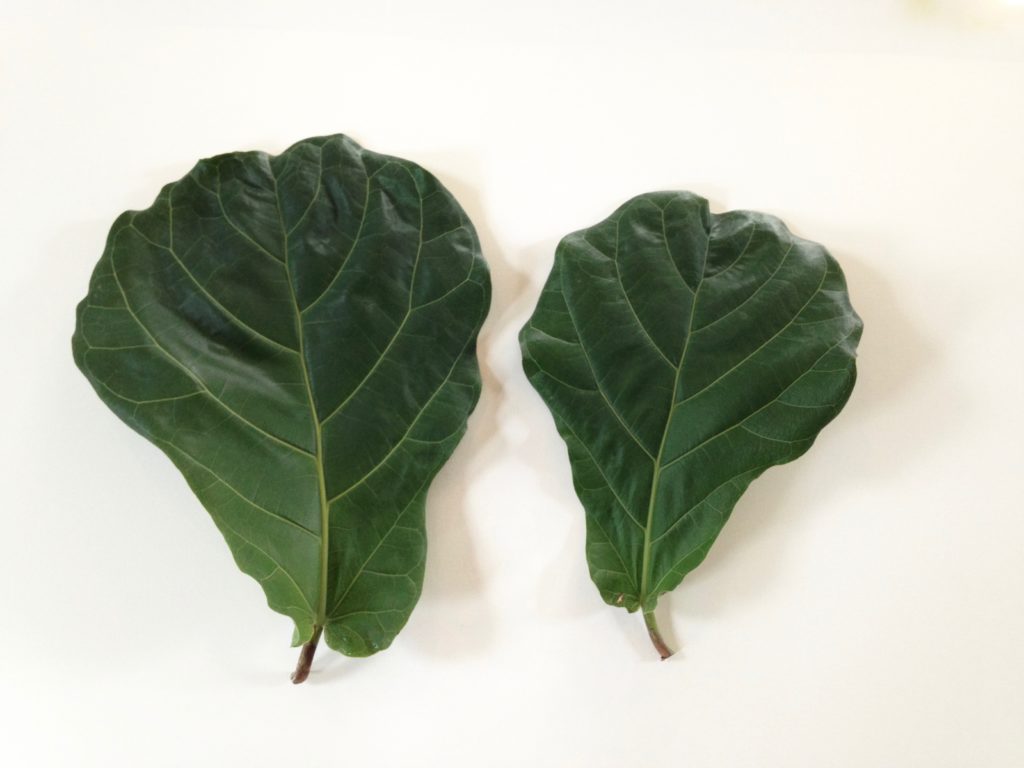
I talk a bit about blind leaf propagation in my Hoya kerrii post, but basically like a Hoya, Ficus lyrata need a stem piece to grow roots which then turn into a plant. A blind leaf will produce exciting roots, but that is all it will produce. Unless there is stem chunk attached, it will only ever create roots. I even tried it. I placed a leaf in water and just roots formed, but never anything else. It does look pretty in a glass jar though.
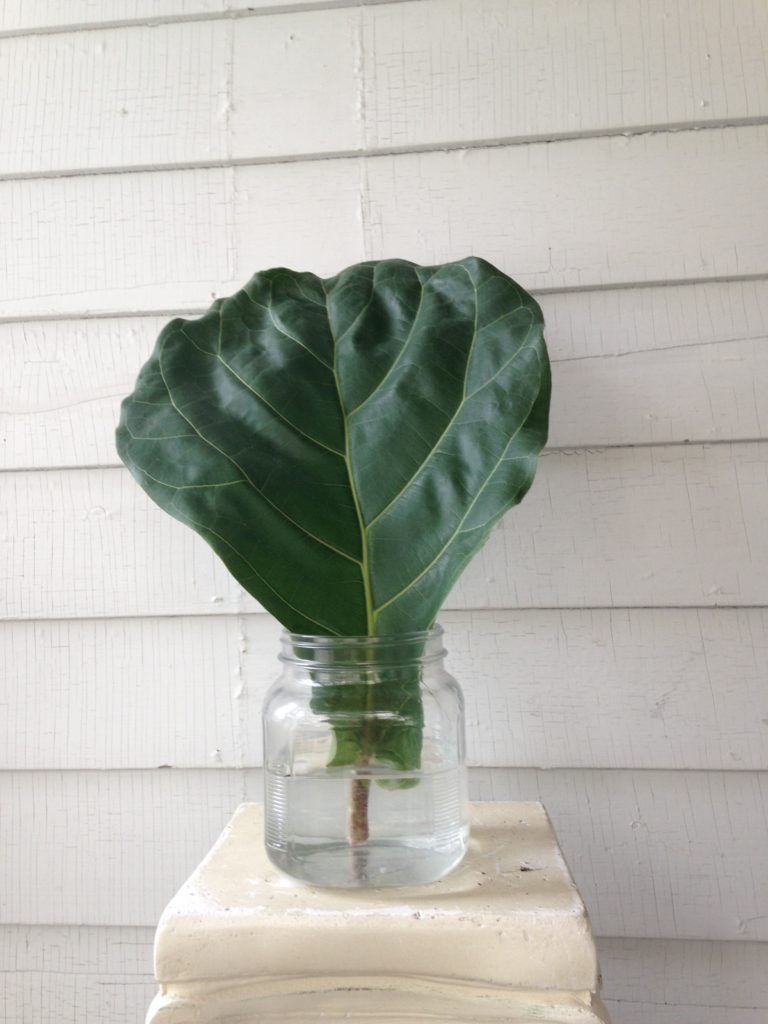
Have questions? Need troubleshooting? Leave a comment below!

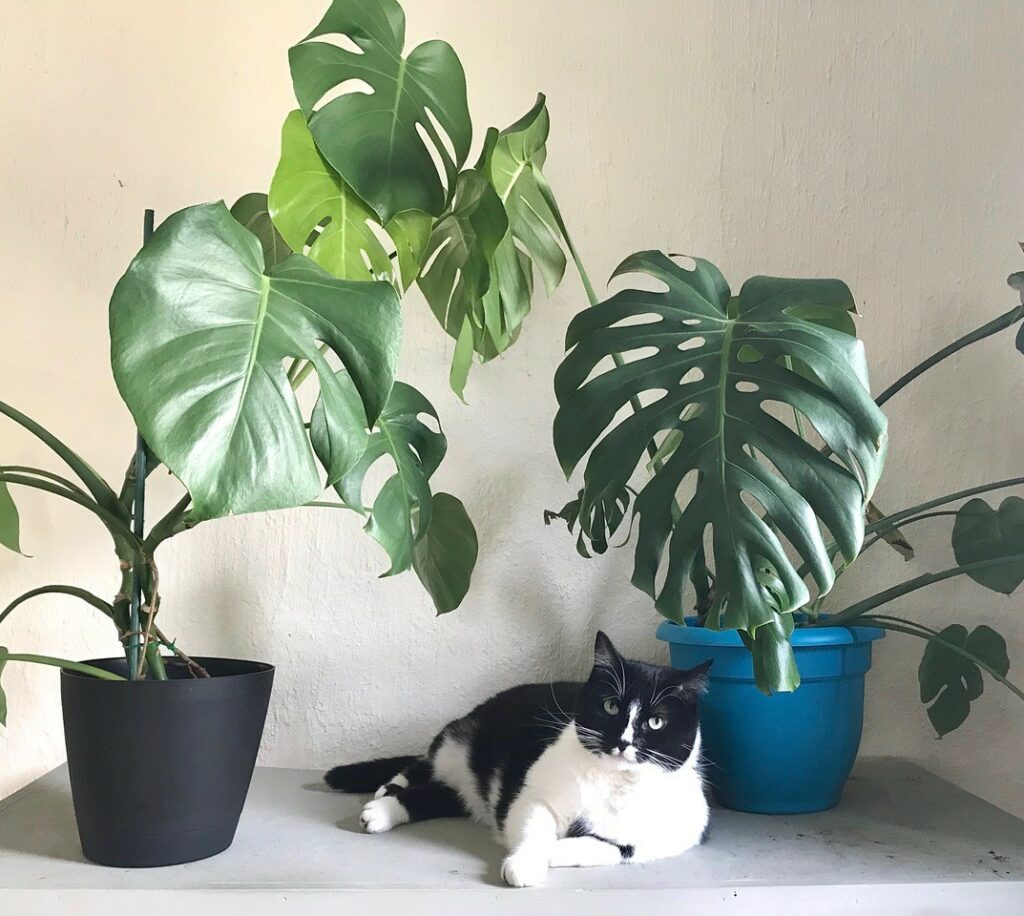

Hi – I need help!! I am new to fiddle leaf figs – a gift from my 85 year old aunt!!! I noticed there are leaves growing from the dirt and they are attached to root chunks from the main plant. I want to save those and propagate them for my two daughters. How do I do this? Could I take a knife and cute off parts of that chunk and root it? Thanks for any help you can provide.
Harriet
Hi Harriet, it’s hard to tell exactly what you mean without pics (you can send some to my FB or IG), but you should be able to cut those off at the base of the plantlet and propagate as I illustrate.
Hi! Great info. I was wondering if you new how to get the fiddle fig to grow new branches so that it can fill out. Mine is doing great on top but would like fuller bottom/middle. Thanks for the help!
Sometimes they’ll start growing branches from the middle in perfect conditions but it’s not that common. Honestly, mine was doing the same thing like yours – I chopped a large chunk off and cut my main stem in half, that allowed more branches to form and he looks much better. Really, there’s no way to like add branches to the middle or bottom, but I wish there was!
You can try slicing about a 1/4“ through the main trunk, mid-way through nodes, to stimulate stem growth. I have not found this successful myself, I’ve tried twice on my 7 footer, but the stem recovered. I can see in theory why this would wok, it’s just not a guarantee. Being a sucker, I’m planning on giving it another shot….
Hi! Thanks for posting this. I am pretty much in same situation with a very tall fiddle (i.e.10ft) with most of the leaves at the very top (at least a foot and a half of stem with leaf) and the rest of stem to bottom has just 3 sprouting new leaves. I was thinking of the air layering technique in which you don’t cut through the stem but score it and then wrap the scored part in sphagnum moss until roots develop then cut the whole thing off and plant in soil once roots are established. I see you had success with cutting the entire top off and placing in water. Can you give any insight to the best technique? Many thanks for your post. Yes you are so right about zero info on cutting into the one and only stalk of the plant. It is very scary and I keep putting it off.
Honestly, air layer is a bit safer. I would lead you that way if you are new to propagating. I have a few Fiddles so I wasn’t super worried if it didn’t work out, but air layering is a great way to see progress and a bit more foolproof! The water way can be a bit hit or miss.
I have a fiddle leaf fig plant, it looks to be about 3 stems and it’s very full and sprouting new leaves weekly. The tallest is starting to lean. It’s still in a planted pot , plant height and not a tall tree yet. Should I propagate now or wait until it is tree height? We are in Florida so the conditions are pretty warm year round.
HI Kathy, It will only continue to lean as it grow but you can try staking it to keep it upright or you can definitely propagate that stem into a new plant. Because you are in FL, you should see new, healthy growth soon after cutting. If you choose to stake, they usually end up needing to be cut eventually anyway, so think of staking as a quick fix and propagating as a long term one.
I am trying to propagate two steams. I put them in the same vase and now the roots are intertwined. I am wanting to pot it, should I try and separate the roots?
You can – it shouldn’t be too hard to separate them as long as they aren’t a root ball mess, which, if they are, just plant them as is. I would try to untangle and if it’s proving difficult or roots are snapping off, let them me conjoined twins and plant them that way.
My FLF was so leggy. It was about 3ft tall with 5 leave on the very top. I cut it and am now propagating it.
Will the main plant still grow without any leaves? The main rootball is still health but now it has no leaves. What do I do with it?
Hi Cindy – They will, it will just take awhile so patience is key. Make sure it’s in a warm location (no drafts) with ample sun and new leaf buds should start forming in a month or so. If it’s winter where you are it might take longer, if summer, shorter. Good luck!
New to fiddle leaf fig , was wondering if it hurt the plant to cut a leaf with a black spot, overwatering at first,
I think. Is it better to leave a quarter sized spot, or could I cut ..do spots hurt anything?
You can cut that leaf off – your plant will be fine and might even pop out one in its place!
Hello! I am trying to propagate a LARGE portion of my previously 11 foot fiddle leaf (I wanted to propagate it by cutting it in half essentially so it would fit in new apartment). I just started 2 large propagations, one 4 feet and one 5 feet long. But I was reading that you’re saying 3-4 leaves max. Will mine with dozens of leaves not survive? I have it sitting in a glass jar with water and a few small drops of plant food in very well-lit area.
Hi Connor – the reasoning behind having only a few leaves per propagation stem is because the cutting will put all of its energy towards keeping those leaves healthy, and not making new roots. This can leave to it rotting in water. You may be able to further chop up these branches (I would anyway) and attempt to propagate as many pieces as possible. It sounds like you have the ideal light set up, so that should work. I hope that helps!
Hi, I recently received 2 fiddle leaf trees that were neglected. All the leaves were gone and left with a stump and about 5 to 6 branches sticking out. Also, the soil was wet and had roots growing out of the pot from the bottom. I just snip down some of the branches so far and placed it in an area with sun. I’m not sure if I should repot it or wait
Please any advice would be much appreciated. The stump is still pretty hardy and when I trimmed the branches there was fluid.coming out.
Hi Jenny, I would not repot at all and I would just let it acclimate to your house for a few months. If it’s spring where you are you should start to see some growth soon on those branches but it may be veerrryyy slow. FLFs are quite slow when they are recovering from damage or neglect. You can always trim the branches further back, but I would just keep in a warm sunny spot, monitor the moisture, and keep an eye on it. The fluid is normal, that’s just what’s in the stem. Hope that helps!
Thank you for your post! My friend has a huge FLF growing outside in her yard. It is taller than her house. Every single time I take cuttings (4 times now) and try to propagate the leaves turn pale (mottled) quickly. I have tried propagating both in water and in soil and in various locations both inside and out as I can get as many cuttings as I want so I get a bunch. 🙂 Any ideas of what I am doing wrong as she is moving in a couple of weeks. Thank you so much.
Hmm, I’m thinking the issue may be there are too many leaves on the cuttings or the cuttings may be in a less than ideal environment (ie: cold or dark area). Definitely make sure the cutting not has 3 leaves max and that there is plenty of clean stem to get placed in water. Lots of warmth and light are needed too. I hope that helps!
Hello thanks for your post it’s been very helpful! I have a beautiful mother plant that got too tall. I managed to notch it successfully a year ago so it has another mature stem (2 including mother stem). I recently gave the mother stem a chop, maybe 3-4 weeks ago now), placed in glass vase of water, changing the water when it’s dirty. I even put the purple propegating growth hormone liquid stuff on it. thought I’d done everything correctly but the cutting has lost its leaves now I’m left with a stalk! It has the little white barnacle dots growing around a ring looking node but in 2 places and not at the base of the stem but about 1cm from base then at the next node about 3inches up. Should I be ditching it? Please help! Also I’m in Brisbane Australia! Thank you Cass
Hi Cass, Hmm, I’m guessing it *is* rooting, so I would cut off anything that looks black or brown or rotten and keep an eye on those barnacles. It sounds promising still so I wouldn’t give up just yet, and sometimes the leaves all do fall off, I’ve had that happen before and still have had a successful rooting!